a&e features
The straight and narrow?
D.C.’s two largest LGBT choirs have straight directors
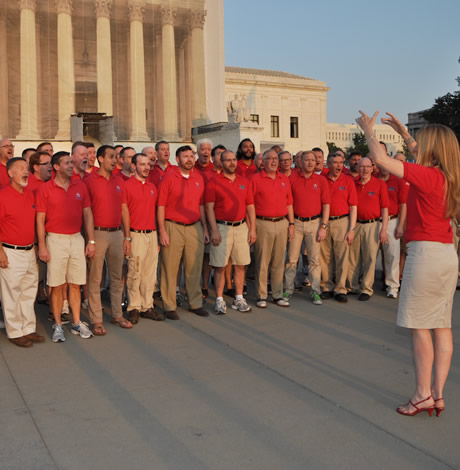
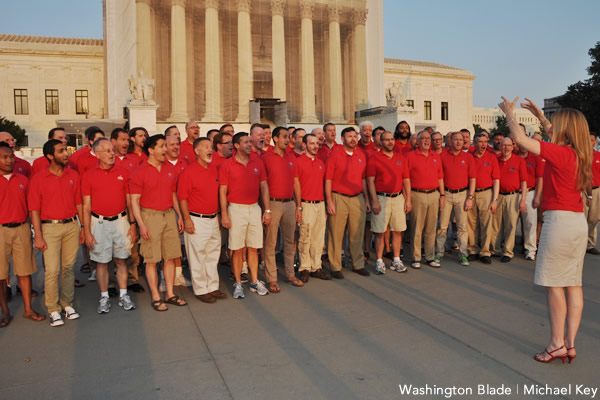
Thea Kano directs the Gay Men’s Chorus of Washington at the U.S. Supreme Court. (Washington Blade photo by Michael Key)
Jeff Herrell, a decade-plus member of Metropolitan Community Church of Washington, the region’s largest mostly LGBT church, was at the Fellowship’s general conference last year and as he sat listening to a pastor from Indianapolis, something he heard rubbed him the wrong way.
The crux of the argument was that if the Fellowship of Metropolitan Community Churches, a network of LGBT-welcoming churches started by Troy Perry in 1968 in the face of almost universal condemnation of gays by mainstream Christian churches, is to survive, it will need to engage straight believers as well.
It’s not a new concept. Many LGBT activists have stated the movement would have achieved far less traction over the past 40-odd years without ally aid. But for Herrell, a Washingtonian of 15 years and a gay believer, the statements inspired an internal groan.
“When I heard that, my first thought was, ‘Oh gosh, really?,’ he says. “It’s a challenge for me because MCC for me is like my personal gay sanctuary away from the straight world in a way.”
A pragmatist, though, Herrell also recognizes the world is changing.
“There is an element of it that’s a little sad, but you know what, we’re old,” he says with a laugh. “This is a post-‘Will & Grace’ world and it’s just not the same as it used to be. It’s like when all the straight girls started going to the gay clubs for their bachelorette parties, you know. I thought, ‘Jesus, I hate this, go somewhere else,’ but you know what? Here we are 10 years later.”
In August, the Gay Men’s Chorus of Washington, a 34-year-old local choir that has about 240 active members and is one of the oldest and largest such groups in the country, announced Thea Kano as its new artistic director. She is the successor to Jeff Buhrman who was at the helm 13 years and involved with the Chorus for 25, and is the first straight director in the group’s history. Chase Maggiano, GMCW’s executive director, says her proven history with the group — she’d been its associate director since 2004 — was considered, but she was given no bonus points over the 30 applicants and four other finalists who applied during a seven-month national search.
“She went through every step of the process just like everyone else,” Maggiano says. “As soon as it was announced that Jeff was resigning, we started getting inquiries. … We figured she would apply but we were up front with her that we were going to take our time to make this a fair and open process so that whomever was ultimately appointed, was legit. We wanted a legitimate and fair process and that was my commitment to the process to kind of be the fairness czar.”
So thorough, in fact, was the process, it was a source of angst for some GMCW singers who’d grown to love Kano and feared she might resign if not given the job.
“We were really happy and really relieved when the news came out that she’d been appointed,” says Eric Peterson, a tenor who’s been in the Chorus five years and is also a member or the Rock Creek Singers, a smaller chamber ensemble within the overall Chorus that Kano has directed for a decade. “I don’t know if she might have stayed either way. She was very careful not to say, but she has a doctorate in choral conducting and has studied and worked with some of the most famous conductors in choral music so I can’t imagine she would have just stuck around indefinitely. … When the news came out, there was a huge sigh of relief and a lot of applause.”
Kano, who splits her time between Washington and the Big Apple directing the 80-voice New York City Master Chorale, says she’s thrilled.
“I’m like a kid in a candy store,” she says. “I really get the best of all worlds here.” She says there was “no yearning” for the chief role even when people started asking her if it was a goal after she’d been with the Chorus a couple years, though she also says when Buhrman announced he was stepping down, applying herself was “a no brainer.”
“Having been here so long, I have that institutional memory and I’ve seen how we’ve grown musically,” she says. “I recognize the things that have really worked and well the audience appreciated this or that. … My goal is to continue with a phenomenal musical product to drive home our overall message of equality.”
When the choir at MCC-D.C. met Michael Fisher Jr., who just started as the church’s “minister of worship arts,” they didn’t know his sexual orientation. The church for years had two choirs with as many as 40-50 singers in the combined group. It has dwindled some in recent years without a full-time director. Several former singers are now active with former director Shirli Hughes’ group Ovation.
Fisher is classically trained on the cello and piano and has worked with several well-known gospel acts. What struck them initially during an audition rehearsal, Herrell says, was his stellar musical ability.
“We just kind of assumed he probably was gay but we didn’t know,” Herrell says. “We had a rehearsal with him and it just went really, really well. He can play the piano like nobody’s business and he’s also just so vocally talented too. … He had a way of teaching that was very easy and he was able to make himself understood. Within like 15-20 minutes, he had us singing a song he’d taught us. It was a great experience and I think everyone was just excited to find someone that talented interested in the position because we have a history of a very strong music program here and it’s something we definitely want to uphold.”
As with the GMCW, the search committee, pastoral staff and board of directors at MCC-D.C., founded in 1970, took its time in the search. All the church’s former choir directors have been LGBT.
Justin Ritchie co-directed the MCC choir for several years with Darius Smith but neither were interested in doing the job full-time. In a series of evaluations, the congregation there — which Herrell guesses is “probably less than 1 percent straight” — wanted someone in this new position in a full-time capacity.
Rev. Cathy Alexander, MCC’s minister of congregational connections, says the process was exceedingly thorough and says she’s excited to see Fisher join the staff. (Fisher did not respond to multiple attempts to interview him before this week’s Blade deadline. He’s started his new post but will be officially welcomed at special services at 9 and 11 a.m. on Sept. 14. The church’s senior pastor, Rev. Dwayne Johnson, also did not respond to interview requests.)
“First and foremost, he’s a very spiritual man, very dedicated to serving God, that came through first and foremost,” Alexander, who identifies as gender non-conforming, says. “He has an amazing ability, he writes his own songs and travels and sings. … He’s very personable and has already established a good relationship with the choir and dance ministries. He grew up in the church playing music, he’s a good fit for this position and his wife is just lovely, too.”
But despite thorough searches and stellar musical qualifications, is there any long-term concern about having the city’s largest LGBT choirs — the Lesbian and Gay Chorus of Washington having folded in 2010 (former director C. Paul Heins is now the GMCW associate director) — under straight leadership?
While several say it is a bit unusual and perhaps a sign of the times, nobody the Blade interviewed said it’s an important distinction. Kano, especially, several GMCW members said, has never inspired any doubt about her commitment to LGBT rights.
Ritchie, who has sung for years with the GMCW in addition to his duties at MCC, concurs.
“Thea has great gay sensibility if you will and she’s a great programmer,” he says. “She’s an artist and the Chorus couldn’t be in better hands. I think it will be a seamless transition with her in charge.”
Ritchie, who has yet to meet Fisher, says the role at MCC is a wholly different situation. He says because the role requires someone who can both conduct and accompany and who is stylistically diverse, it was a hard position to fill.
“At 9, it’s more like high church, then at the 11 o’clock service it’s straight-up black gospel and there are not many people who can do it all. I kind of faked my way through it for a year and a half … but it’s such a varied position.”
The spiritual component only further complicates the matter, Ritchie says.
“Concerned is probably too strong of a word and it’s really not my business anymore, but I would want to be sure that whomever they might have hired for this position has the best of intentions,” he says. “Is it somebody who really feels called to this church or is it just somebody who needed a job? That would be understandable, but it would be my hope that they would make sure it’s not somebody who’s coming in to convert anybody. It’s just so hard to fully understand the gay faith community in the context of past hurt or past injury if you haven’t experienced it that way. … There has to be not only the musicality, but also the safety and the celebration of who LGBTQ people are.”
Neither appointment is an anomaly, as far as anybody can tell. Other choruses within the Gay and Lesbian Association of Choruses (GALA) have had straight directors, although it is certainly not the norm.
Robin Godfrey, GALA’s executive director and a lesbian, says she’s known of some straight conductors but says she’s not given much thought to how widespread the phenomenon might be.
“It’s certainly not the sort of thing we would ask,” she says. “In some cases, there may be straight conductors you may know of, but how many, I really don’t know.”
Rev. Kharma Amos, associate director of formation and leadership development for Metropolitan Community Churches and a Fairfax, Va., resident and lesbian, says she has no idea how many of the Fellowship’s 200-plus congregations around the world might have straight music ministers. She says a “wild guess” might be that “30 or 40” MCC churches in the U.S. are large enough to have full-time music staff. All candidates for ordination in the Fellowship go through classes she helps lead and she says about two of the 15 who come through each year identify as straight.
“It’s hard to generalize as to the whys, but often they’ve identified the inclusivity MCC exhibits as being extraordinary compared to other denominations and they felt a calling to social justice issues,” Amos says.
Ritchie says he knows of several paid musicians at MCC churches in Minneapolis and Ft. Lauderdale who are straight though he says, “the vast majority are LGBT.”
Kano, who grew up in the San Francisco area, knew many gay dancers studying ballet growing up and says “it was just never an issue.” She eventually came to consider herself an LGBT activist and says upon finishing graduate school at UCLA and applying to conducting jobs “all over,” a friend in Los Angeles heard GMCW had an open position 10 years ago.
“My first thought was, ‘Why would they want me,’ but he said, ‘Well, you’re a gay activist and always have been,’ so I sent in my resume and fast forward, here we are. That’s how it came to be on my radar,” she says.
Nobody the Blade spoke to said the appointments raised any eyebrows within the two choirs.
“When DOMA was struck down, she was the one who was there singing with us at the Supreme Court all day,” Peterson says. “She was wiping tears and it wasn’t just for us, it was for the entire movement. … She’s such an ally, I really do consider her part of the LGBT umbrella. I don’t think of many straight people in my life that way, but she is an exception.”
Herrell, too, says he “didn’t hear anybody say anything” about Fisher and potential concerns.
If anything, Herrell says it would have been hypocritical for MCC to have not considered a straight candidate considering the church’s mantra toward being open and welcoming to all.
“There’s really no valid reason why a heterosexual can’t be the music director for a gay church especially when the message we’re hearing from the pulpit every Sunday is one of radical inclusiveness. … I can honestly say, there was nobody who was like, ‘Hold on, let’s slow down here,’ — nothing like that was said that I know of.”
Although most would agree that’s the politically correct answer, is it any different when an organization’s entire raison d’être is LGBT based? As Whitman-Walker Health has broadened its scope in recent years and has a straight executive director (Don Blanchon), will this phenomenon spill over into our traditionally gay churches and arts organizations? Some national gay rights groups, like the National Black Justice Coalition, have directors who are straight allies. And Washington’s LGBT amateur sports teams are reporting higher levels of straight participation than ever before, Team D.C. officials say. Lines everywhere seem to be blurring as the gay rights movement gains increased footing.
Gay directors applied for both jobs but those involved in the searches said when all factors were considered, Kano and Fisher were the best fits.
“Of the five finalists, I can say yes, some of them were gay,” Maggiano says. “But we really didn’t have a cut-and-dried scenario where all other factors were equal and we had to decide on that. We did not discriminate on gender, religion, sexual orientation or anything else. … We just didn’t find ourselves in a situation where it was a gay versus a non-gay issue.”
But what does it mean? Is it coincidence? A sign of the changing times? The first steps in the what could be a gradual “de-gaying” of our traditional LGBT safe spaces? As a point of context, Dignity Washington, a local LGBT Catholic group, has had a straight choir director for years. Members say it’s never been an issue. She’s low key, though, and asked that her name not be used as she also directs music in local Roman Catholic parishes and doesn’t want to risk drawing the ire of anti-gay church leaders, a threat organist and choir director Mike McMahon of National City Christian Church knows is very real. He lost his job at St. Agnes Catholic Church in Arlington after he married his male partner earlier this year.
He says there are many factors at play with the new choir directors, but says it ultimately shouldn’t be an issue.
“What we’re seeing is the results of the mainstreaming of gay culture,” McMahon says. “It’s a thing that cuts both ways. Once it’s OK for gay people to have a certain job, then it’s OK for straight people to have these more traditionally gay jobs as well. With (Kano) especially, the issue is not that she’s straight or that she’s a woman. She’s been immersed in that environment for so many years and has shown that she has the chops to make those guys sound amazing. I think it’s great.”
Anthony Heilbut knows what it’s like to be considered an outsider. He’s a self-described Jewish atheist but as a life-long lover of black gospel music who eventually came to be considered an expert on the subject as a producer of many traditional gospel acts and author of “The Gospel Sound” and “The Fan Who Knew Too Much.”
Heilbut says many may not realize the long tradition “children,” historically the term black Christians used for the low-key gays and lesbians in their ranks, have of being choir directors.
“In gospel music, the greatest choir directors have almost universally been gay men,” Heilbut, who’s gay, says. “This situation here in D.C. strikes me as just a curiosity and a fascinating situation because it really should not be hard to find a gay choir director of all things. … This is just one area in which gay men have always excelled, going all the way back to James Cleveland and before.”
Maggiano says GMCW is “actually ramping up our gayness.”
“I know it might sound strange considering we just hired a straight female, but what we’re really doing is inviting people to come be gay with us. Let your hair down. Put on a wig. In this market, it’s cool to be gay. … We would actually love it if in 10 years we had half gay men and half straight singing ‘YMCA.’ How great would it be to see some straight guy just wailing on Beyonce? What a great place we would have come to and what a great statement that we got here through music. … That’s our goal. Not to stay internal and stay exclusively gay, but to make gay cool for everybody.”
Godfrey puts it more succinctly.
“There’s no reason it has to be an issue,” she says.
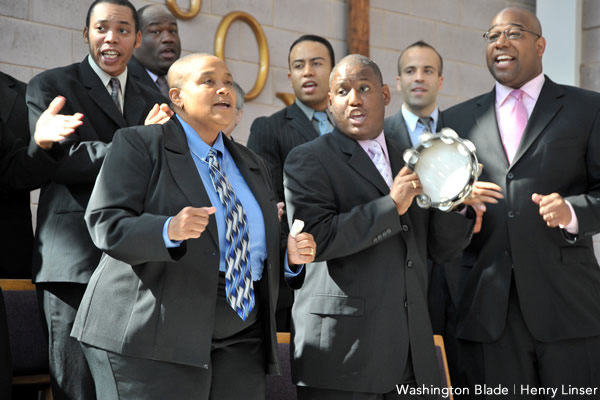
The choir at Metropolitan Community Church of Washington in 2008. (Washington Blade file photo by Henry Linser)
a&e features
Local, last-minute holiday gift ideas
Celebrate the season while supporting area businesses

The DowntownDC Holiday Market is bustling. Union Station is decked out with its annual Christmas tree. Washingtonians have wrapped their houses and apartment balconies with festive lights and holiday decorations. The holiday season is here. And with stockings to fill and empty space under the tree, Washington’s local shops and artists have plenty to offer.
Show your LGBTQ and D.C. pride with the Washington Blade’s annual holiday gift guide.
To embrace the holiday buzz: The Blanco Nwèl cocktail from Alchy Cocktails. This Caribbean eggnog is one of Alchy Cocktail’s seasonal holiday cocktails. The flavor profile is similar to coquito, a traditional Puerto Rican Christmas drink with a coconut base. As a queer and Caribbean-owned business, Alchy Cocktails has been based out of Washington since 2021. Blanco Nwèl is available in both cocktail ($24) and mocktail ($12) online and at a variety of holiday markets, including the Tingey Plaza Holiday Market, the Flea Market at Eastern Market, Union Station’s Main Hall Holiday Market, and more. ($24)

A spicy bite: Gordy’s Cajun Okra from Salt and Sundry. These spicy, tangy pickles pull on Southern Cajun-style flavors, packing a punch with paprika, cayenne, and more. Gordy’s is an LGBTQ-owned and Washington-based brand, making this gift an opportunity to support a local LGBTQ business straight from the jar. This pantry staple is available on Salt & Sundry’s website and at its locations in Union Market, Logan Circle, and its Georgetown holiday pop-up store. ($14)


To celebrate Washington pride: The DC Landmark Tote Bag from The Neighborgoods. Native Washingtonians, visitors, friends and family alike will find something to love about this Washington-themed tote bag. Food trucks, the 9:30 Club, the Metro logo and pandas from the National Zoo are just some of the city’s landmarks depicted across the tote in a red, white, and blue color palette. The tote is a part of the DC Landmarks collection, which donates 10 percent of its sales to the American Civil Liberties Union. The Neighborgoods itself is a local, woman-owned business built out of a passion for screen-printing in 2013. The 100 percent cotton canvas tote is for sale online or at the DowntownDC Holiday Market. ($22)
To give friends and family their flowers: The Flowers Bandana from All Very Goods. This 100 percent cotton bandana was designed in Washington and hand printed in India. Its uniqueness comes in being covered with the faces of Black women, representing a “love letter to all women but especially Black women,” according to All Very Goods. The Black woman-owned and operated business, based out of Northwest Washington, has a mission to celebrate diversity and representation through its products. The bandana intends to give Black women their “flowers.” The Flowers bandana is available for purchase online. ($24)

To unlock culinary creativity: The Curious Chef Gift Collection from Each Peach Market. This customizable collection of kitchen oddities — ranging from tinned fish to chili oil — is a quirky gift for the most inventive chefs. The collection is available in a Standard Santa, Extra Goodies and Super Holiday Size for up to $165. The Washington-based market, founded in 2013, permits customers to make the collection special by specifying what unique ingredients are packaged, including products made by local or LGBTQ brands. Each Peach Market offers assembly and pick up in-person at its Mount Pleasant shop and also offers local delivery and nationwide shipping via its website. ($85)

To give a touch of sweetness: The DC Landmark Chocolate Covered Oreo Holiday Cookies from Capital Candy Jar. Wrapped in a festive red bow, this box of nine cookies embraces love for Washington and the holiday season in one. Among the dark and milk chocolate covered cookies are images of the U.S. Capitol, the White House, the Lincoln Memorial, the Jefferson Memorial and festive hollies. The treat, packaged in a Hill East facility just a few blocks from the Capitol, is available for purchase online and at the DowntownDC Holiday Market. ($23.95)


To celebrate queer gaming: Thirsty Sword Lesbians from Labyrinth Games & Puzzles. This roleplaying game embraces lesbian culture by unlocking a world of swords, romance, and battle. Ideal for group settings, the book presents a system of world building and character identities that are best brought to life by creative minds. Labyrinth, which has been a local Washington business for more than 15 years, celebrates non-digital fun through games and puzzles that connect the community. This gift is offered online and at Labyrinth’s Capitol Hill location. ($29.99)
To make a bold statement: The “Resist” T-shirt from Propper Topper. This locally screen-printed black tee features the Washington flag designed within a raised fist, symbolizing both Washington pride, and political resistance. The shirt is made exclusively by Propper Topper, a local Washington business that evolved from a hat shop to a gift store since opening in 1990. The tri-blend unisex shirt is available both for pickup at Propper Topper’s Cathedral Heights location and shipping via the online site. ($32)

To keep it c(g)lassy: The Glass Ball earrings from Blue Moon Aquarius. Gifting can rarely go wrong when it comes to a new pair of earrings. The unique statement earrings — made of polymer clay, glass, and 18k gold plating over surgical steel — are hand cut, sanded and assembled in Washington, meaning each set is unique. Blue Moon Aquarius, a local brand, is known for its small batch jewelry and home decor designed with clay materials. Available in oxblood, hunter green, lavender, and bluestone color palettes, these earrings are available for purchase on Blue Moon Aquarius’ website and at the DowntownDC Holiday Market. ($48)
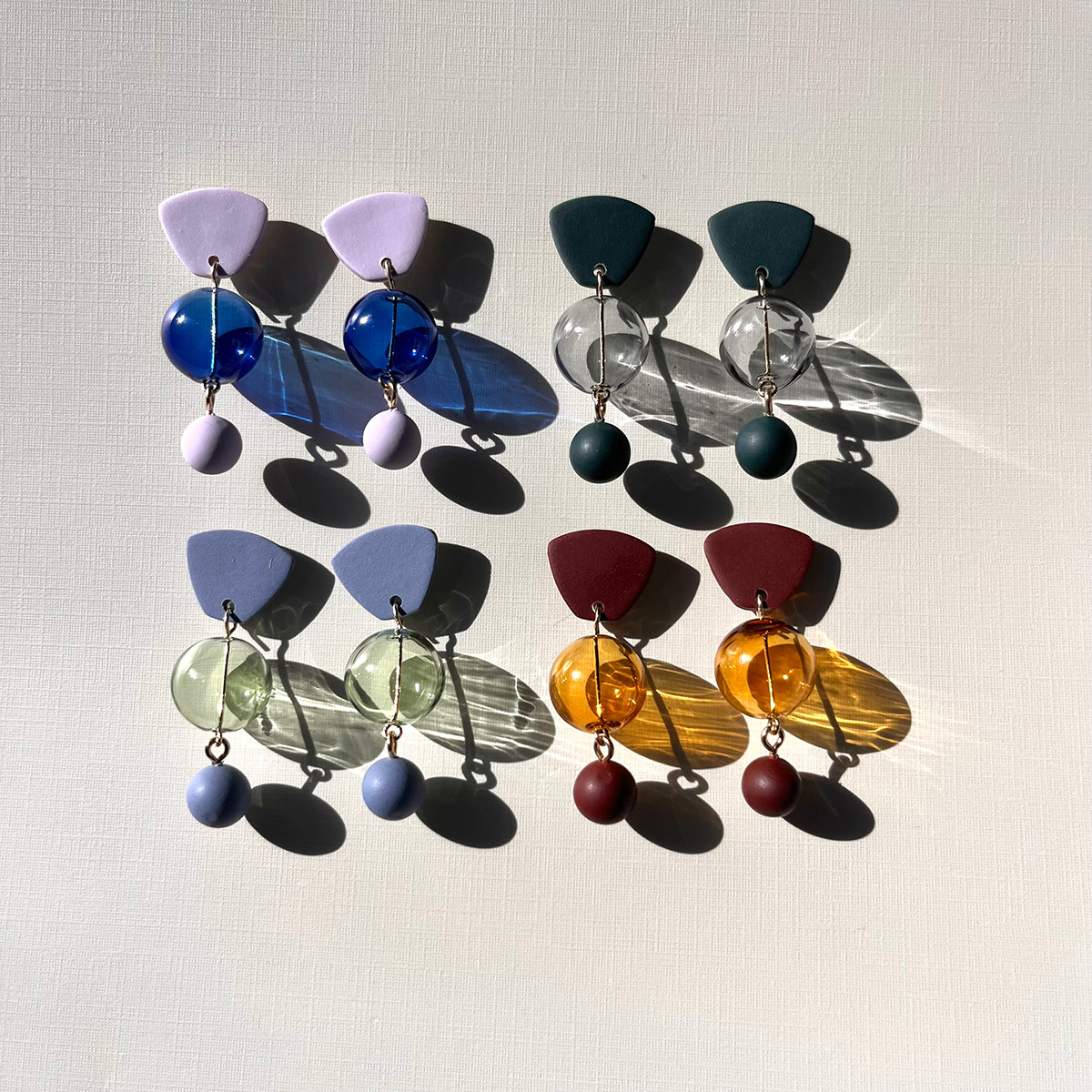
To elevate a holiday tea or charcuterie party: The Honey Flight: Tea Lover’s Selection from BannerBee. This local honey company presents the ideal gift to make cozying up with a cup of tea slightly more special. The Honey Flight contains three types of raw wildflower honey infused with fair trade Ugandan vanilla bean, chai spices, and locally sourced lemon thyme herb. The gift is also an opportunity to uplift a family company based in the Mid-Atlantic that offers all-natural, sustainable products. The flight is available online, at the DowntownDC Holiday Market or at the Arlington Courthouse and Dupont Farmers’ Markets. ($36)

For Baltimore shoppers: If you’re in Charm City, don’t miss Balston Mercantile, opened by a gay couple in June. Their gorgeous shop in the Hampden neighborhood offers an array of unique, upscale finds, from barware and artwork to cookbooks and home decor and more. (849 W. 36th St.)
a&e features
Have yourself a merry John Waters Christmas
Annual holiday show returns to Alexandria and Baltimore
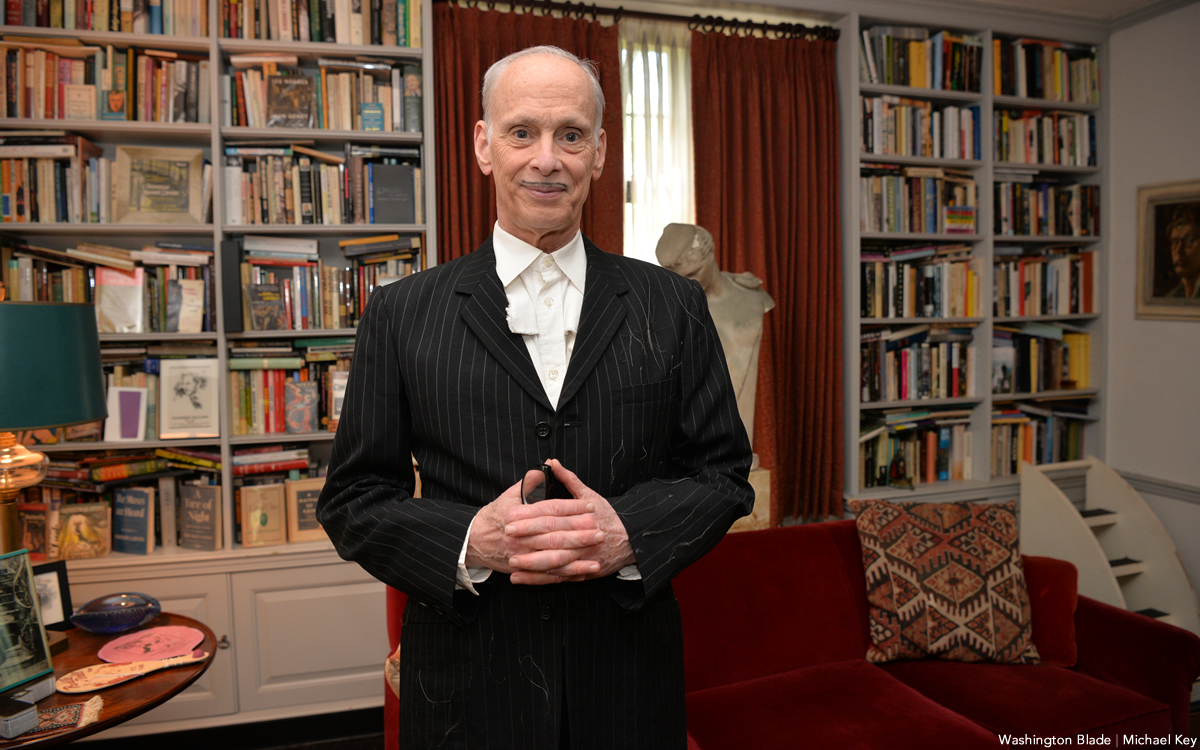
When it comes to iconic Christmas scenes in movies, none can top the tree-toppling tantrum thrown by cha-cha heels-deprived Dawn Davenport in John Waters’s fifth full-length feature “Female Trouble” from 1974. Therefore, it’s not surprising that Waters continues to make art out of Christmas, performing his spoken word Christmas tour in cities across the country. Waters has even more reason to celebrate with the release of his new red vinyl 7” single, a cover of Little Cindy’s “Happy Birthday Jesus (A Child’s Prayer)” on the A-side, and “A Pig Latin Visit From St. Nicholas” on the B-side. If you’re still looking for unique Christmas gifts, consider this record. As always, John was kind enough to make time for an interview in advance of his tour dates.
BLADE: John, in preparation for this interview with you, I went back and listened to Little Cindy’s original rendition of “Happy Birthday Jesus (A Child’s Prayer)” on your “A John Waters Christmas” CD.
JOHN WATERS: One thing I did, if you notice, I make the same stumble in my recording that she did in the original.
BLADE: It sounded to me like she got choked up.
WATERS: No, I think she just stumbles over a word, so I stumbled over the same word. It’s appropriation, insanely.
BLADE: Is this a song you first became aware of in your youth or when you were an adult?
WATERS: When I was doing the Christmas album, I had this friend named Larry Benicewicz. He was kind of my idea man with music. He knew every single old record. I would say to him, “Weird Christmas songs,” when we were doing a soundtrack, or a song about bears, or a song about this, and he would give me all these tapes. It was one of the ones he played for me. A lot of the songs I put in my movies and on my records, I did know as a kid. I did not know this one, but I immediately embraced it. I don’t think it’s campy. I think it really is spiritual in a weird way. My doing it makes it a novelty record. I am really for novelty records, and there aren’t any anymore. Why was there not a COVID novelty record? That’s insane. The dance “The Bug” that’s on the “Hairspray” soundtrack would be perfect for COVID.
BLADE: The thing that struck me was that for a Christmas song in the voice of a child, a kind of death pall hangs over it, with lines like, “If I was good you’d let me live with you” and “they nailed you to the cross, they wanted you to die.”
WATERS: All of it! When I see children at midnight mass kneeling in front of a nude man nailed to a cross, I feel like I’m at The Eagle! It is S&M, it’s creepy. I took the same cover (photo) from her record to parody and put my face on it. The same thing I did with The Singing Dogs last year when I covered (their version of) “Jingle Bells.” I’m really into novelty records. I love them and I’m trying to bring them back. I don’t expect anybody to ever play these records. Even The Singing Dogs one said on it, “Please do not play this record” [laughs]. And the flipside, the Pig Latin version, is almost impossible to listen to.
BLADE: I’m so glad you mentioned that. “A Pig Latin Visit From St. Nicholas” reminded me of the lost art of speaking in Pig Latin. I also recall watching the PBS series “Zoom” as an adolescent and learning to speak “ubbi dubbi,” a distant relative of Pig Latin. Do you think that the time is right for a Pig Latin or ubbi dubbi revival?
WATERS: Here’s the thing, I never could pick up any language, except Pig Latin. I’ve been in every foreign country. Foreign countries have given me money to learn to speak the language. I can never do it! But Pig Latin…my parents and other parents in the ‘50s spoke Pig Latin so kids couldn’t understand what they were saying. Then my mother taught it to me, and I used it. The hardest take to shoot in “Pink Flamingos” was not eating the dog shit. It was when the cast skipped, in one take, saying “E-way, are-yay e-they ilthiest-fay eople-pay in-hay e-they ole-hay ide-way orld-way.” We’re the filthiest people in the whole wide world in Pig Latin. We had to do so many takes so they could do it once without screwing it up. In “Polyester,” Edith (Massey) answers the phone, “ello-hay.” I did a photo piece where it was all subtitled in Pig Latin. Like “osebud-Ray” (from “Citizen Kane”) or in “Streetcar,” “ella-Stay!” [Laughs] All the iconic dialogue translated into Pig Latin. My assistant who helped me do it, had never heard of Pig Latin. She really got good at it because she lived in many foreign countries and can pick up languages. But it’s not that easy to do it correctly and read it. Your computer will translate into Pig Latin.
BLADE: AI understands Pig Latin?
WATERS: I guess that’s AI. It wasn’t 100% right, but it was close. I can speak it if I look at it, but just do a bit at a time. It was a challenge that no one would possibly care about or want to do.
BLADE: I think you pulled it off very well.
WATERS: If you want people to leave on Christmas morning, you put it on. That’s how you get your guests to leave. It’s time to go.
BLADE: Ood-gay i-bay! How did your relationship with record label Sub Pop, which released 2021, 2022, 2024, and new 2025 holiday singles, come about?
WATERS: I believe the first thing I did for them was “Prayer to Pasolini.” They came to me through Ian Brennan. He’s won a couple Grammys for World Music, but he is also is one of my agents who does the Christmas tour and a lot of my shows, anything with music. He helped me arrange each one of the songs. He had a relationship with Sub Pop. It was perfect. My friends in Baltimore, (the band) Beach House, have had huge success.
BLADE: That’s right, they’re on Sub Pop!
WATERS: Yes! I’m happy to be on it. I’ve even been to the warehouse and posed for pictures like Jackie Suzanne used to do.
BLADE: Is there any chance that “A John Waters Christmas” might be reissued on vinyl by Sub Pop?
WATERS: No. It’s such a nightmare to get the rights and to renew them. You have to find the publisher and the writer, and they usually hate each other. It doesn’t matter if it’s obscure or famous, it’s hard to get. You have to make the deal. The singer doesn’t get anything unless they play it on the radio. It would be so complicated legally, and there would be such a [laughs] tiny audience for it. I hope it will come out again. The same thing with the one for Valentine’s Day. I had two of them that did quite well when they came out; “A Date With John Waters and “A John Waters Christmas.” The “John Waters Christmas” album is still the soundtrack that plays whenever I’m doing my spoken word Christmas show as people are entering the theater.
BLADE: Aside from your annual Christmas show tour, what else do you do for the holidays now, and are there any traditions that you’ve carried over from your family?
WATERS: Certainly! I have two sisters, my brother’s widow, and me, so there are four and we take turns each year to have the Christmas dinner. Mine was last year. An entire sit-down dinner. Mom’s China, the silverware, the entire full dinner. It’s pretty traditional. I don’t have a Christmas tree, but I do decorate the electric chair from “Female Trouble.” That is a tradition in my family. We do have Christmas decorations, but they’re usually weird ones that fans sent me. I have one with Divine knocking over the Christmas tree, and the Christmas tree lights up, all sorts of amazing things. There is definitely a tradition here that might be a little altered, but it is definitely a tradition. I used to have a giant party every year, but COVID ended that. I still wouldn’t want 200 people in my house breathing right now.
BLADE: I was looking at your tour schedule and wondered if there are any new cities in which you’ve never performed the John Waters Christmas show that have been added to this year’s schedule?
WATERS: I don’t think there’s a city in America in which I haven’t done one show! The only places I haven’t been to are Hawaii and Alaska. I could do it there, but it’s too long on a tour. I can’t think of a city I haven’t played in in America over the last 50 years. The Christmas show is completely different every year. It doesn’t matter if you saw it last year.

Some gifts scream practical, others whisper luxury, and a few flat-out blur the lines. From cocoa that feels ceremonial to a cologne that linger like a suggestive smirk, this year’s ultimate gift picks prove that thoughtful (and occasionally naughty) presents don’t have to be prosaic. Welcome to your holiday cheat sheet for festive tangibles that get noticed, remembered, and maybe even result in a peck of gratitude planted under the mistletoe. Consensually, of course.
Amber Glass Champagne Flutes
Pop the champs – but make it vintage. These tulip-shaped stunners in amber-tinted glass bring all the Gatsby vibes without the Jazz-age drama. Whether you’re toasting a milestone or celebrating a Tuesday, their seven-ounce capacities and hand-wash-only care make ‘em as practical as they are pretty. Pair with a thoughtful bottle of bubs and gift with a glittering wink. $18, NantucketLooms.com
Disaster Playbook by Here Comes the Apocalypse
Because the end of the world shouldn’t be a solo act, this spiral-bound guide is your step-by-step roadmap to surviving and thriving when everything else goes sideways, which might be sooner than you think. Packed with checklists, drills, and a healthy dose of humor, it’s like a survival manual written by your most prepared (and slightly snarky) friend. Whether you’re prepping for a zombie apocalypse or, more realistically, REVOLUTION!, this playbook’s got your back. $40, HereComesTheApocalypse.com

Wickless Vulva Candles
Bold, luxurious, and completely flame-free, CTOAN’s wickless candles melt from beneath on a warmer, releasing subtle, sophisticated fragrances, like sandalwood or lavender. The vulva-shaped wax adds a playful, provocative element to any space –perfect for a bedroom, living room, or anywhere you want elegance with an edge. A gift that celebrates form, intimacy and self-expression, no fire required. $39, CTOANCO.com
Villeroy & Boch Royal Classic Christmas Collection
Every meal is a mini celebration – with whimsy at every place setting – in Villeroy & Boch’s Royal Classic festive dinnerware collection that hits all the right notes. Made from premium German porcelain, it features nostalgic little toys, nutcrackers, and rocking horses in delicate relief, giving your holiday spread a playful but refined twist. Dishwasher- and microwave-safe, it’s luxe without the fuss. Gift a piece to a special someone, or start a collection they’ll use (and show off) for years to come. $22-$363, Villeroy-Boch.com
Greenworks Electric Lawnmower
You a ’hood queen who considers lawn care performance art – or just wants to rule the cul-de-sac in quiet, emission-free glory? Greenworks’ zero-turn electric mower has the muscle of a 24-horsepower gas engine but none of the fumes, drama or maintenance. Six 60V batteries and a 42-inch deck mean you can mow up to two-and-a-half acres on a single charge – then plug in, recharge, and ride again. It’s whisper-quiet, slope-ready, and smooth enough to make you wonder why you ever pushed anything besides your queer agenda. The perfect gift for the homeowner who loves sustainability, symmetry, and showing off their freshly striped yard like that fresh fade you get on Fridays. $5,000, GreenworksTools.com
Molekule Air Purifier
For the friend who treats their space like a sanctuary (or just can’t stand sneezes), the Molekule Air Pro is magic in motion. Covering up to 1,000 square feet, it doesn’t just capture allergens, VOCs, and smoke – it destroys them, leaving your air feeling luxury-clean. FDA-cleared as a Class II medical device, it’s serious science disguised as modern design. Gift it to your city-dwelling, pet-loving, candle-burning friend who likes their living room as pristine as their Instagram feed. $1,015, Molekule.com

Cipriani Prosecco Gift Set
Effervescent with stone-fruit sweetness and a touch of Italian flair, the Cipriani Bellini & Prosecco gift set brings brunch-level glamour to any day of the week. The Bellini blends rich white-peach purée with sparkling wine, while the dry ’secco keeps things crisp and celebratory. Pop a bottle, pour a flute, and suddenly winter weeknights feel like a party – even with your pants off. $36, TotalWine.com
Woo(e)d Cologne
British GQ recently crowned Woo(e)d by ALTAIA the “Best Date Night Fragrance,” and honestly, they nailed it. Confident without being cocky – smoky gaïac and Atlas cedarwood grounds the room while supple leather and spicy cardamom do all the flirting – it’s a scent that lingers like good conversation and soft candlelight. Gift it to the one who always turns heads – or keep it for yourself and let them come to (and then on) you. $255, BeautyHabit.com

Lococo Cocoa Kit
Keep the run-of-the-mill mugs in the cabinet this Christmas and pull out Lococo’s handcrafted Oaxacan versions that demand you slow down and sip like it matters. Paired with a wooden scoop, rechargeable frother, and Lococo’s signature spice hot-chocolate blend (vegan, gluten-free, with adaptogenic mushrooms), this holiday kit turns Mexi-cocoa into a mini ritual you’ll look forward to. Perfect for anyone who loves a little indulgence with a side of ¡A huevo! energy.
Manta Sleep Mask
Total blackout, zero pressure on the eyes, and Bluetooth speakers built right into the straps, this ain’t your mama’s sleep mask — but it could be. The Manta SOUND sleep mask features C-shaped eye cups that block every hint of light while ultra-thin speakers deliver your favorite white noise, meditation, or late-night playlist straight to your ears. With 24-hour battery life, breathable fabric, and easy-to-adjust sound, it turns any bed (or airplane seat) into a five-star sleep suite. Perfect for anyone who treats shut-eye like an art form (or just wants to escape their roommate’s late-night bingin’ and/or bangin’). $159, MantaSleep.com

Shacklelock Necklace
Turn the industrial-chic vibe of a shackle into a sleek statement. Mi Tesoro’s platinum-plated stainless-steel necklace sits on an 18-inch wheat chain, featuring a shackle-style latch pendant that’s waterproof, tarnish-free, and totally fuss-les. Beyond style, it nods to a classic gesture in the queer leather community: replacing a traditional Master lock with something elegant to quietly signal belonging to someone special. Wear it solo for a minimalist edge or layer it like you mean it; either way this piece locks in both your look and your intentions. $90, MiTesoroJewelry.com
Parkside Flask Mojave Edition
Wine nights get a desert glow-up with Parkside’s limited-edition 750-milliliter all-in-one flask draped in sun-washed bronze and badland hues like sage, sand, and terracotta – with magnetic stemless tumblers that snap on for effortless shareability. It keeps your vino chilled for 24 hours, pours without drips (no tears for spilled rosé, please), and even lets you laser-engrave your own mantra or inside joke. Perfect for picnics, surprise rooftop clinks, or gifting to your favorite wine (or desert) rat. $149, HighCampFlasks.com

Mikey Rox is an award-winning journalist and LGBT lifestyle expert whose work has published in more than 100 outlets across the world. Connect with him on Instagram @mikeyroxtravels.
-

 Politics3 days ago
Politics3 days agoLGBTQ Democrats say they’re ready to fight to win in 2026
-

 District of Columbia2 days ago
District of Columbia2 days agoBrian Footer suspends campaign for Ward 1 D.C. Council seat
-

 Chile5 days ago
Chile5 days agoFar-right José Antonio Kast elected Chile’s next president
-

 Opinions3 days ago
Opinions3 days agoLighting candles in a time of exhaustion




















